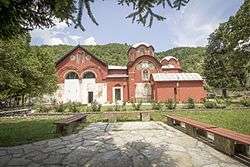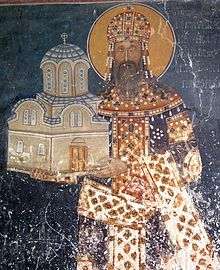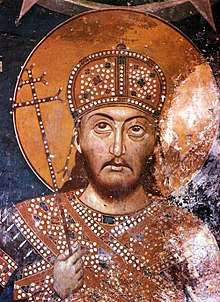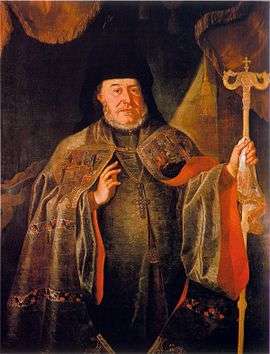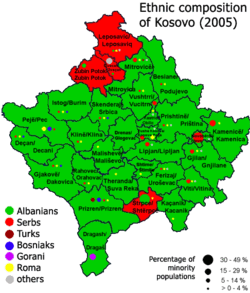Kosovo Serbs
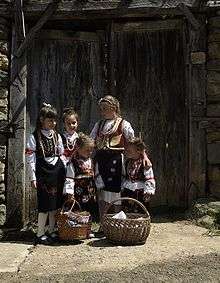 Girls from Štrpce in Serbian traditional costumes | |
| Total population | |
|---|---|
| 146,128 (2013 est.)[1] | |
| Languages | |
| Serbian | |
| Religion | |
| Serbian Orthodox Church |
| Part of a series of articles on |
| Serbs |
|---|
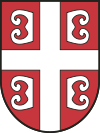 |
|
Native communities |
|
Related groups |
Kosovo Serbs are the largest ethnic minority group in Kosovo[a], numbering around 150,000 people.[2][3] Kosovo was the cultural, diplomatic and religious core of the medieval Serbian state.
Because of Serbian medieval history and monuments, Kosovo has long been called the "Serbian Jerusalem".[4][5] The Medieval Monuments in Kosovo, founded by the Nemanjić dynasty, is a combined World Heritage Site consisting of four Serbian Orthodox Christian churches and monasteries.
The region of Kosovo was an important part of the 14th-century Serbian Empire, with Prizren serving as capital, until its subsequent occupation by the Ottomans following the Battle of Kosovo (1389), considered one of the most notable events of Serbian history.[6] After centuries of foreign Ottoman rule, Kosovo was annexed by the Kingdom of Serbia in 1912, following the First Balkan War. It was then part of Serbia (and later Yugoslavia), until the 1999 Kosovo War resulted in the de facto separation of Kosovo from the rest of Serbia, followed by its secession from Serbia in 2008 which is not wholly and legally recognised by the international community.
Most of Kosovo's pre-1999 Serb population relocated to central Serbia and Montenegro following ethnic cleansing campaigns[7] while many of the remaining Serbs outside North Kosovo live in small isolated communities, called enclaves.
Demonym
The formal names for the Serb community in Kosovo is "Serbs in Kosovo and Metohija" (Srbi na Kosovu i Metohiji) or "Serbs of Kosmet" (Kosmetski Srbi), in use by the community itself and the Serbian government. They are also referred to as Serbs of Kosovo (Serbian: Косовски Срби/Kosovski Srbi) or Serbs in Kosovo (Serbian: Срби на Косову/Srbi na Kosovu, Albanian: Serbët në Kosovë). The term "Kosovo Serbs" is predominantly used in English. They are known by the demonym Kosovci,[8] though this is properly used for inhabitants of the region of Kosovo (in the narrow sense – centred around the Kosovo Field), along with Metohijci (of Metohija).[9]
Medieval period
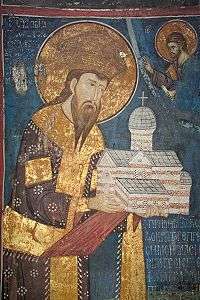
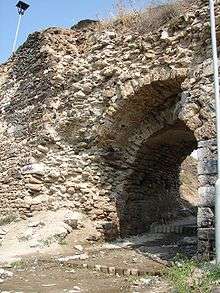
Right: Main Gate of the Fortress in Prizren, which Stefan Dušan used as capital of Serbian Empire
Sclaveni raided and settled the western Balkans in the 6th and 7th century.[10] The Serbs are mentioned in De Administrando Imperio as having settled the Balkans during the reign of Emperor Heraclius (r. 610–641), however, research does not support that the Serbian tribe was part of this later migration (as held by historiography) rather than migrating with the rest of Early Slavs.[11] Through linguistical studies, it is concluded that the Early South Slavs were made up of a western and eastern branch, of parallel streams, roughly divided in the Timok–Osogovo–Šar line.[12] Parts of northwestern Kosovo were part of the Serbian Principality. In the late 9th century the region was seized by the First Bulgarian Empire, while the region switched hands between the Byzantines and Bulgarians until the Byzantine restoration of 1018–19. In 1040–41 a massive Slavic rebellion broke out, which included Kosovo. Another rebellion broke out in 1072, in which Serbian prince Constantine Bodin was crowned Emperor of Bulgaria at Prizren,[13] however, despite some initial success, Bodin was eventually captured in southern Kosovo and the rebellion was suppressed.[14][15] Vukan, the new independent Serbian Grand Prince, began raiding Byzantine territories, first in Kosovo, advancing into Macedonia (1091–95). He broke several peace treaties concluded personally with the Byzantine Emperor at Zvečan and Lipljan, until finally submitting in 1106.
In 1166, a Serbian prince, Stefan Nemanja, the founder of the Nemanjić dynasty, asserted independence after an uprising against the Byzantine Emperor Manuel I Comnenus.[16] Nemanja defeated his brother, Tihomir, at Pantino near Pauni, and drowned him in the Sitnica river. Nemanja was eventually defeated and had to return some of his conquests, and vouched to the Emperor that he would not raise his hand against him. In 1183, Stefan Nemanja embarked on a new offensive allied with the Kingdom of Hungary after the death of Manuel I Komnenos in 1180, which marked the end of Byzantine domination over the region of Kosovo. Nemanja's son, Stefan, ruled a realm reaching the river of Lab in the south. Stefan conquered all of Kosovo by 1208, by which time he had conquered Prizren and Lipljan, and moved the border of his realm to the Šar mountain. In 1217, Stefan was crowned King of Serbs, due to which he is known in historiography as Stefan "the First-Crowned".[17]
In 1219, the Serbian Church was given autocephaly, with Hvosno, Prizren and Lipljan being the Orthodox Christian eparchies with territory in modern-day Kosovo. By the end of the 13th century, the centre of the Serbian Church was moved to Peć from Žiča. King Stefan Dušan founded the great Monastery of the Holy Archangel near Prizren in 1342–52. The Serbian Kingdom was elevated into an Empire in 1345–46. Stefan Dušan received John VI Kantakuzenos in 1342 at Pauni to discuss an alliance against the Byzantine Emperor. In 1346, the Serbian Archbishopric at Peć was upgraded into a Patriarchate, but it was not recognized before 1375. After the death of Dušan in 1355, the fall of the Serbian Empire began, with feudal disintegration during the reign of his successor, Stefan Uroš V (r. 1355–71).[18] Parts of Kosovo became domain of Vukašin Mrnjavčević, but Vojislav Vojinović expanded his demesne further onto Kosovo. The armies of Vukašin from Pristina and his allies defeated Vojislav's forces in 1369, putting a halt to his advances. After the Battle of Maritsa on 26 September 1371 in which the Mrnjavčević brothers lost their lives, Đurađ I Balšić of Zeta took Prizren and Peć in 1372. A part of Kosovo became the demesne of the Lazar of Serbia.
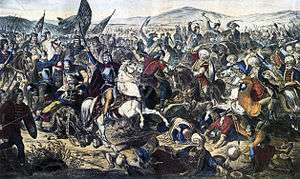
The Ottoman Empire invaded the realm of Prince Lazar on 28 June 1389, at the Battle of Kosovo near Pristina, at Gazimestan. The Serbian army was led by Prince Lazar who led 12,000–30,000 men against the Ottoman army of 27,000–40,000 men. Lazar was killed in battle, while Sultan Murad also lost his life, believed to have been assassinated by Serbian knight Miloš Obilić. The outcome of the battle is deemed inconclusive, with the new Sultan Bayezid having to retreat to consolidate his power. Vuk Branković came to prominence as the local lord of Kosovo, though he was an Ottoman vassal at times, between 1392 and 1395.[19]
Another battle occurred between the Hungarian troops supported by the Albanian ruler George Kastrioti Skanderbeg on one side, and Ottoman troops supported by the Branković dynasty in 1448. Skanderbeg's troops which were going to help John Hunyadi were stopped by the Branković's troops, who was more or less an Ottoman vassal. Hungarian King John Hunyadi lost the battle after a 2-day fight, but essentially stopped the Ottoman advance northwards. Kosovo then became vassalaged to the Ottoman Empire, until its direct incorporation as the Vilayet of Kosovo after the final fall of Serbia in 1459.
In 1455, new castles rose to prominence in Pristina and Vučitrn, centres of Branković District.
Ottoman period
The Ottomans brought Islamisation with them, particularly in towns, and later also created the Kosovo Vilayet as one of the Ottoman territorial entities. During the Islamisation many Churches and Holy Orthodox Christian places were razed to the ground or turned into mosques. The big Monastery of Saint Archangels near Prizren was torn down at the end of the 16th century and the material used to build the Mosque of Sinan-pasha, an Islamized Albanian, in Prizren. Although the Serbian Orthodox Church was officially abolished in 1532, an Islamized Serb from Bosnia, Grand Vizier Mehmed-pasha Sokolović influenced the restoration of the Serbian Patriarchate of Peć in 1557. Special privileges were provided, which helped the survival of Serbs and other Christians on Kosovo.[20]
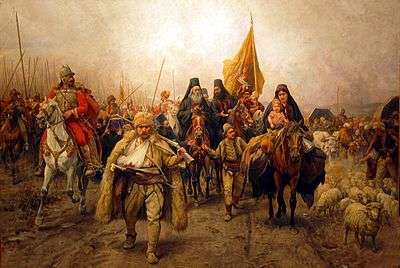
Kosovo was taken by the Austrian forces during the War of the Holy League (1683–1698). In 1690, the Serbian Patriarch of Peć Arsenije III, who previously escaped a certain death, led 37,000 families from Kosovo, to evade Ottoman wrath since Kosovo had just been retaken by the Ottomans.[21] The people that followed him were mostly Serbs, but there were numerous Orthodox Albanians and others too. 20,000 Serbs abandoned Prizren alone. Due to the oppression from the Ottomans, other migrations of Orthodox people from the Kosovo area continued throughout the 18th century. It is also noted that some Serbs adopted Islam and some even gradually fused with the predominantly Albanians and adopted their culture and even language. By the end of the 19th century, Albanians replaced the Serbs as the dominating nation of Kosovo.[3]
In 1766 the Ottomans abolished the Serbian Patriarchate of Peć and the position of Christians on Kosovo was greatly reduced. All previous privileges were lost and the Christian population had to suffer the full weight of the Empire's extensive and losing wars, even to take the blame for the losses.
Albanians formed the nationalistic League of Prizren in Prizren in the late 19th century. The Aim of the League of Prizren was to unite the four Albanian-inhabited Vilayets by merging the majority of Albanian inhabitants within the Ottoman Empire into one Albanian Vilayet. However at that time Serbs were opposing the Albanian nationalism along with Turks and other Slavs in Kosovo, which disabled the Albanian movements to establish Albanian rule over Kosovo.
In 1901, massacres of Serbs were carried out by Albanians in North Kosovo and Pristina.
The arising Principality of Serbia planned a restoration of its rule on Kosovo as Ottoman might crumbled on the Balkan peninsular. The period witnessed a rise of Serbian nationalism. Serbia's plans for a post-Ottoman period included the return of Kosovo.
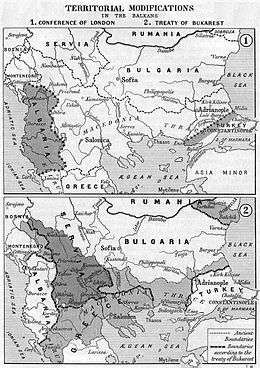
During the First Balkan War, the Kingdom of Serbia and the Kingdom of Montenegro fought alongside the Kingdoms of Greece and Bulgaria as part of the Balkan League to drive the Ottoman forces out of Europe and to incorporate the spoils into their respective states. Serbia, Montenegro and Greece had occupied the entire Western Balkan (Albanian-inhabited territories) with the exception of Vlora in the hope of achieving recognition with their new borders. Resistance from the Albanians across their entire region in favour of their own proposed independent nation state led to fighting between the Balkan League armies (less geographically uninvolved Bulgaria) and Albanian forces. To end the conflict, the Treaty of London decreed an independent Principality of Albania (akin to its present borders), with most of the Vilayet of Kosovo awarded to Serbia and the Metohija region awarded to Montenegro.[22][23]
20th century
World War I and First Yugoslavia
During the First World War, in the winter of 1915–1916, the Serbian army withdrew through Kosovo in a bid to evade the forces of the Central Powers. Thousands died of starvation and exposure. In 1918, the Serbian army pushed the Central Powers out of Kosovo, and the region was unified as Montenegro subsequently joined the Kingdom of Serbia. The monarchy was then transformed into the Kingdom of Serbs, Croats and Slovenes.
The 1918–1929 period of the Kingdom of Serbs, Croats and Slovenes witnessed a decrease in the Serbian population of the region and an increase in the number of Albanians. In 1929, the state was renamed the Kingdom of Yugoslavia. The territories of Kosovo were split among the Zeta Banovina, the Banate of Morava and the Banate of Vardar. The state lasted until the World War II invasion and Axis occupation of Yugoslavia (1941).
World War II
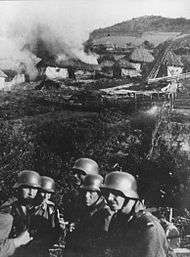
After the invasion of Yugoslavia (6–18 April 1941), the Axis powers divided territory among themselves. Kosovo and Metohija was divided between Italian, German and Bulgarian occupation. The largest part of what is today Kosovo was under Italian occupation and was annexed into a "Greater Albania", the Albanian Kingdom through a decree on 12 August 1941, while northern parts were included in German-occupied Serbia, and southeastern parts into the Bulgarian occupational zone.[24] Parts of eastern Montenegro and western Macedonia were also annexed to Albania.
During the occupation, the population was subject to expulsion, internment, forced labour, torture, destruction of private property, confiscation of land and livestock, destruction and damaging of monasteries, churches, cultural-historical monuments and graveyards.[24] There were waves of violence against Serbs in some periods, such as April 1941, June 1942, September 1943, and continuous pressure in various ways.[25] Civilians were sent to camps and prisons established by the Italian, German and Bulgarian occupation, and the Albanian community.[26] The expulsion of Serbs proved problematic, as they had performed important functions in the region, and been running most of the businesses, mills, tanneries, and public utilities, and been responsible for most of the useful agricultural production.[27] Most of the war crimes were perpetrated by the Vulnetari ("volunteers"),[28] Balli Kombëtar and the SS Skanderbeg Division.[29] The Skanderbeg Division was better known for murdering, raping, and looting in predominantly Serbian areas than for participating in combat operations on behalf of the German war effort.[30] The most harsh position of Serbs was in the Italian (Albanian) zone.[31] A large part of the Serb population was expelled or forced to flee in order to survive.[31] Serbian estimations put the number of expelled at around 100,000; an estimated 40,000 from the Italian-occupation zone, 30,000 from the German zone, and 25,000 from the Bulgarian zone.[32]
Second Yugoslavia
The Province of Kosovo was formed in 1946 as an autonomous region to protect its regional Albanian majority within the People's Republic of Serbia as a member of the Federal People's Republic of Yugoslavia under the leadership of the former Partisan leader, Josip Broz Tito, but with no factual autonomy. After Yugoslavia's name changed to the Socialist Federal Republic of Yugoslavia and Serbia's to the Socialist Republic of Serbia in 1953, the Autonomous Region of Kosovo gained some autonomy in the 1960s. In the 1974 constitution, the Socialist Autonomous Province of Kosovo's government received higher powers, including the highest governmental titles – President and Premier and a seat in the Federal Presidency which made it a de facto Socialist Republic within the Federation, but remaining as a Socialist Autonomous Region within the Socialist Republic of Serbia. Serbian (called Serbo-Croatian at the time) and Albanian were defined official on the Provincial level marking the two largest linguistic Kosovan groups: Serbs and Albanians. In the 1970s, an Albanian nationalist movement pursued full recognition of the Province of Kosovo as another Republic within the federation, while the most extreme elements aimed for full-scale independence. Tito's government dealt with the situation swiftly, but only gave it a temporary solution. The ethnic balance of Kosovo witnessed unproportional increase as the number of Albanians rose dramatically due to higher birth rates.[33] Serbs barely increased and dropped in the full share of the total population down to 10% due to higher demographic raise of the Albanian population.
In 1981, Albanian students organized protests seeking that Kosovo become a Republic within Yugoslavia. Those protests were harshly contained by the centralist Yugoslav government. In 1986, the Serbian Academy of Sciences and Arts (SANU) was working on a document, which later would be known as the SANU Memorandum. An unfinished edition was filtered to the press. In the essay, SANU explained the Serbian peoples history as victims of a 500-year and more genocide from Kosovo, and therefore called for the revival of Serb nationalism. During this time, Slobodan Milošević's rise to power started in the League of the Socialists of Serbia. Milošević used the discontent reflected in the SANU memorandum for his political goals.
One of the events that contributed to Milošević's rise of power was the Gazimestan Speech, delivered in front of 1,000,000 Serbs at the central celebration marking the 600th anniversary of the Battle of Kosovo, held at Gazimestan on 28 June 1989.
Soon afterwards, as approved by the Assembly in 1990, the autonomy of Kosovo was revoked back to the old status (1971). The proclamation of an autonomous Kosovo by Tito and his communists was in fact a part of Tito's hope to continue the communist Yugoslavia. He had said "Strong Serbia, Weak Yugoslavia – Weak Serbia, Strong Yugoslavia" Milošević, however, did not remove Kosovo's seat from the Federal Presidency. After Slovenia's secession from Yugoslavia in 1991, Milošević used the seat to attain dominance over the Federal government, outvoting his opponents.
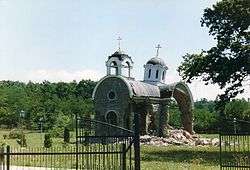
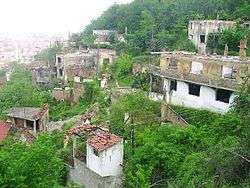
Right: Ruins of a Serb part of Prizren destroyed during 2004 pogrom.
Breakup of Yugoslavia and Kosovo War
After the Dayton Agreement of 1995, the Kosovo Liberation Army, ethnic-Albanian paramilitary organisation that sought the separation of Kosovo and the eventual creation of a Greater Albania,[34] began attacking Serbian civilians and Yugoslav army and police, bombing police stations and government buildings, killing Yugoslav police and innocent people of all nationalities, even Albanians who were not on their side.[35] This triggered a Yugoslav interior ministry counter strike, aiming at crippling KLA-members, but since this was a guerilla organization it was hard to establish civilians from insurgents, and Albanian Americans started a lobby in the United States congress. The numbers that US, UK, NATO and UN officials operated with were around 10,000 Kosovo Albanians killed.[36] This triggered a 78-day NATO campaign in 1999. As of 2014, mass graves of Kosovar Albanian victims are still being found.[37] There have been many reports of abuses and war crimes committed by the KLA during and after the conflict, such as massacres of civilians (Lake Radonjić massacre, Gnjilane, Staro Gracko, Klečka etc.), prison camps (Lapušnik), organ theft and destruction of medieval churches and monuments.
The leaders of the new state of 'Kosovo' have been implicated in the Albanian war crimes.[38]
According to the 1991 Yugoslavia census, there were 194,190 Serbs in Kosovo[39] however with the arrival of NATO, a large number of Serbs fled or were expelled and many of the remaining civilians were subjected to abuse.[40][40][41][42][43][44] During the unrest in Kosovo, 35 churches and monasteries were destroyed or seriously damaged. After Kosovo and other Yugoslav Wars, Serbia became home to highest number of refugees and IDPs (including Kosovo Serbs) in Europe.[45][46][47]
In total, 156 Serbian Orthodox churches and monasteries have been destroyed since June 1999, after the end of the Kosovo War and including the 2004 pogrom. Many of the churches and monasteries dated back to the 12th, 13th and 14th centuries.[48] KLA fighters are accused of vandalizing Devič monastery and terrorizing the staff. The KFOR troops said KLA rebels vandalized centuries-old murals and paintings in the chapel and stole two cars and all the monastery's food.[49]
21st century
The interim Kosovo government unilaterally declared independence from Serbia on Sunday, 17 February 2008.[50] Serbia refuses to recognise this declaration of independence. Kosovo's self-proclaimed independence has been recognised by 113 UN countries, and one non-UN country, the Republic of China (Taiwan). The remaining Serbs from North Kosovo want to remain in the Republic of Serbia, but Serbian majority towns are now rare in the Albanian-dominated, partially recognised Republic of Kosovo.
Some officials in the Serbian government have proposed the partitioning of Kosovo, with North Kosovo and Štrpce becoming part of Serbia or given autonomy. The United States opposes the partition of Kosovo, stressing that the "great majority of countries around the world are not going to stand for that."[51] In response to the seizure of railways in Northern Kosovo and formation of Serbian offices to serve as part of a parallel government, Kosovo's Prime Minister stated that they would "not tolerate any parallel institution on Kosovo's territory" and would assert their authority over all of Kosovo.[52] The UN's Special Representative in Kosovo said the "international community has made it very clear that no partition of Kosovo will be acceptable."[53] Ivan Eland, a Senior Fellow at the Independent Institute, suggested such "a partition within a partition" would prevent a "Serbia-Kosovo War" and provides the "best chance" of Kosovo having a long-term stable relationship with Serbia.[54] Chairman of the Serb Municipalities of Kosovo Alliance Marko Jakšić dismissed the talk of partition and said the action of Serbs in Kosovo is to protest the Kosovo declaration. Oliver Ivanović, a Kosovo Serb political leader, said he was against Kosovo's partition because "most Serbs live south of the Ibar and their position would become unsustainable".[55] A Reuters analysis suggested that Kosovo may be divided along ethnic lines similar to Bosnia-Herzegovina. James Lyon of the International Crisis Group thinktank was quoted as saying, "the Republika Srpska style is acceptable for Serbia, but within the confines that it (Kosovo) is still part of Serbia."[56] Pieter Feith, the European Union's special representative in Kosovo, and the International Civilian Representative for Kosovo said no plans are under discussion to carve out a canton or grant any other autonomy to Serbs living in the north of Kosovo. He told the Pristina, Kosovo, daily Koha Ditore, "It is quite clear that the privileged relations between the Serbs here (in Kosovo) and Belgrade are in the spheres of education, health care, and religious objects," adding that "the government in Pristina has to be respected."[57]

On 30 September 2008, Serbian President Boris Tadić stated that he would consider partitioning Kosovo if all other options were exhausted. The former Foreign Minister for Serbia and Montenegro, Goran Svilanović, applauded the suggestion saying "finally this is a realistic approach coming from Serbia. Finally, after several years, there is a room to discuss."[58] After his comments aroused controversy in the media, Tadić reiterated that he was suggesting this as a possibility only if all other options were exhausted.[59] Kosovo's parliamentary speaker, Jakup Krasniqi, condemned any suggestion of partitioning saying, "All of those who aim to divide Kosovo, I want to say, it will end in nothing. Serbs lost their right to Kosovo with the unjust war against the Albanian majority."[60]
Since the Brussels Agreement of 2013, where Serbia agreed to grant the government in Pristina authority over Kosovo and Metohija, Serbs have accepted many aspects of Pristina government's rule. They now vote on republic of Kosovo central election Commission ballots in local elections. Mayors like Goran Rakic of North Mitrovica and Kosovo assembly members loyalty oaths to the Republic of Kosovo.[61] Krstmir Pantic of North mitrovica could not become mayor because he refused to sign the oath to the republic of Kosovo after he was chosen in the elections of 2013. Kosovo Serb policeman must take an oath when they join the Kosovo police to the Republic of Kosovo. Kosovo Serbs who serve in the legal system must take the Republic of Kosovo bar exam to practice law.
Demographics
| Year | Albanians | Serbs | Others |
|---|---|---|---|
| 1455[62][63] | 1 % | 96 % | 3 % |
| 1871[64] | 32 % | 64 % | 4 % |
| 1899[65] | 48 % | 44 % | 8 % |
| 1921 | 69 % | 26 % | 15 % |
| 1931 | 60 % | 27 % | 13 % |
| 1948[66] | 68 % | 24 % | 8 % |
| 1953 | 65 % | 23 % | 11 % |
| 1961 | 67 % | 23 % | 9 % |
| 1971 | 73 % | 18 % | 8 % |
| 1981 | 77 % | 13 % | 9 % |
| 1991[39] | 82 % | 10 % | 8 % |
| 2000[67] | 88 % | 7 % | 5 % |
| 2007[67] | 92 % | 5 % | 3 % |
During the 20th century, the Serb population of Kosovo constantly decreased. After the Middle Ages, the Serbs continued to be the absolute majority of the population of present-day Kosovo; through the 15th, 16th, and late 17th century, evident from Latin and Venetian travellers, such as Jacob Soranzo (1575), bishop Marin Bizzi (1610), ethnic Albanian bishop Petar Mazarek (1623), and bishop Giorgio Bianchi (1638).[68] Today, Serbs mostly populate the enclaves across Kosovo, as well as compact North Kosovo where they comprise 95% of population and whose 1,200 km2 (463 sq mi) comprise 11% of Kosovo's territory. Diplomats from the United Nations have voiced concern over slow progress on Serb rights.[69] Human Rights Watch pointed out discrimination against Serbs and Roma in Kosovo immediately after the War in Kosovo.[70]
ECMI calculated, based on 2010 and 2013 estimations, that ca. 146,128 Serbs resided in Kosovo, that is, ca. 7.8% of the total population.[1] In 2012, the Helsinki Committee for Human Rights in Serbia estimated that the number was 90–120,000.[71] The Republic of Kosovo-organized 2011 census did not take place in North Kosovo, and was boycotted by a considerable number of Serbs in southern Kosovo.[1] The ECMI did call "for caution when referring to the 2011 Census in Kosovo".[72] There are ten municipalities constituted by a Serb numerical majority.[1] These are the four northern municipalities of North Mitrovica, Leposavić, Zvečan, Zubin Potok, and the six southern (enclave) municipalities of Gračanica, Štrpce, Novo Brdo, Ranilug, Parteš and Klokot.[1]
Some 205,835 Kosovo Serbs were displaced in Serbia in 2009.[73] As of 2015, there are at least 6,600 Kosovo Serb refugees in Montenegro.[74] In 2003, the number was c. 12,000.[75] The numbers do not include those that have received Montenegrin citizenship.


| Municipality | Percentage | Number | Description |
|---|---|---|---|
| North Mitrovica | 76.48% | 22,530 | North Kosovo |
| Gračanica | 82.15% | 21,534 | Enclave |
| Leposavić | 96% | 18,000 | North Kosovo |
| Zvečan | 96.1% | 16,000 | North Kosovo |
| Zubin Potok | 93.29% | 13,900 | North Kosovo |
| Štrpce | 70.58% | 9,100 | Enclave |
| Novo Brdo | 61.46% | 5,802 | Enclave |
| Ranilug | 97.15% | 5,718 | Enclave |
| Parteš | 99.96% | 5,300 | Enclave |
| Gjilan | 5.29% | 5,000 | |
| Klokot | 71.23% | 3,500 | Enclave |
| Vučitrn | 4.79% | 3,500 | |
| Kamenica | 8.01% | 3,019 | |
| Obilić | 12.37% | 3,000 | |
| Lipljan | 3.37% | 2,000 | |
| Pristina | 1% | 2,000 | |
| Istok | 4.16% | 1,700 | |
| Orahovac | 1.76% | 1,000 | |
| Peć | 1.03% | 1,000 | |
| Kosovo Polje | 2.51% | 900 | |
| Klina | 1.53% | 600 | |
| Skenderaj | 0.59% | 300 | |
| Vitina | 0.59% | 280 | |
| Prizren | 0.13% | 237 | |
| Ferizaj | 0.06% | 60 | |
| Štimlje | 0.18% | 49 | |
| Deçan | 0.11% | 46 | |
| Gjakova | 0.02% | 17 | |
| Mitrovica | 0.02% | 14 | |
| Podujevo | 0.01% | 12 | |
| Dragaš | 0.02% | 7 | |
| Suva Reka | <0.01% | 2 | |
| Kaçanik | <0.01% | 1 | |
Albanisation
The term Arnauti or Arnautaši was coined by ethnographers for "Albanised Serbs"; Serbs who had converted to Islam and went through a process of Albanisation.[76][77] It is claimed that more than 10,000 ethnic Serbs have had their names Albanised, e.g. from Nikolić to Nikoliqi, Petrović to Petroviqi, and their nationality changed from "Serbian" to "Kosovan". This has been interpreted by some as a form of ethnic cleansing.[78]
Culture


Right: Gračanica monastery painting by Nadežda Petrović.
The Battle of Kosovo is particularly important to Serbian history, tradition, and national identity.[79]
Eparchy of Raška and Prizren of Serbian orthodox church take care of Serbian people and Orthodox heritage in Kosovo Metohija. Numerous Serbian Orthodox monasteries and churches are spread around Kosovo and Methoja. Some of them include: Banjska monastery, Devič monastery, Gračanica monastery, Patriarchal Monastery of Peć, Visoki Dečani monastery.
Medieval fortifications built by Serbian rules and lords present important cultural heritage.
In connection with social gatherings among the Serbs around the churches and monasteries called Sabori during the Slava and Hram (Patron of the monastery) there was a belief that everyone must dance (to instrumental accompaniments) in order to gain and secure good health. In upper Prizren the Sabor was held on 21 November by the ruins of the monastery of the Holy archangel founded by the Serbian Emperor Stefan Dušan the Mighty in the 14th century. There was also great social gatherings at the Kaljaja fortress.[80]
Serbian folk music is rich in a large number of songs from Kosovo and Metohija, which were especially preserved in the performances of Jordan Nikolić and Mara Đorđević.
The Serbs in Kosovo speak the dialects of Zeta-South Raška, Kosovo-Resava, and Prizren-South Morava.
UNESCO World Heritage Sites
Prominent people
Monarchs

- Vukan, Grand Prince of Serbia
- Stefan Milutin, King of Serbia and founder of Novo Brdo Fortress, Gračanica monastery, Our Lady of Ljeviš and Banjska monastery
- Stefan Dečanski, King of Serbia and founder of Visoki Dečani
- Stefan Dušan, King and Emperor of Serbia, he used Prizren as the capital of the Serbian Empire, founder of Monastery of the Holy Archangels
- Lazar of Serbia, Serbian ruler who led the army in the Battle of Kosovo
- Dragana of Serbia, Bulgarian empress consort
- Musić noble family
- Jelena Balšić, Serbian noblewoman
- Jovan Dragoslav, Serbian nobleman
- Janja Kantakouzenos, Serbian nobleman
- Mladen, magnate and vojvoda
- Vuk Branković, lord of District of Branković
- Đurađ Branković, lord of District of Branković
- Mara Branković
- Kantakuzina Katarina Branković
- Mahmud Pasha Angelović, Grand Vizier of the Ottoman Empire
- Mihailo Anđelović, magnate
- Radič, Grand Čelnik
Politicians
- Radivoje Milojković, prime minister of Principality of Serbia
- Dušan Mugoša, Presidents of the Assembly of SAP Kosovo
- Ilija Vakić, Chairman of the Executive Council of SAP Kosovo
- Bogoljub Nedeljković, Chairman of the Executive Council of SAP Kosovo
- Dragan Tomić, acting President of Serbia
- Aleksandar Tijanić, Minister of Information of Serbia and director of the Radio Television of Serbia
- Ivica Dačić, Prime Minister of Serbia
- Bogoljub Karić, businessman and politician
- Jorgovanka Tabaković, Governor of the National Bank of Serbia
- Slobodan Petrović, Deputy Prime Minister of Republic of Kosovo
- Aleksandar Jablanović, Minister of Communities and Returns of Republic of Kosovo
- Branislav Grbić, Minister of Communities and Returns of Republic of Kosovo
- Dalibor Jevtić, Minister of Communities and Returns of Republic of Kosovo
- Oliver Ivanović
- Borislav Pelević
- Goran Svilanović
- Dragan Velić
- Radovan Ničić
Religious people
- Saint Sava, first Archbishop of the Serbian Orthodox Church and founder of the Monastery of Peć
- Arsenije Sremac, secound Archbishop of the Serbian Orthodox Church and first who resided in the Monastery of Peć
- Joanikije II, Archbishop of Peć and first Serbian Patriarch
- Pajsije, Archbishop of Peć and Serbian Patriarch
- Arsenije IV Jovanović Šakabenta, Archbishop of Peć and Serbian Patriarch
- Vladislav the Grammarian, monk, scribe, historian and theologian
- Lazar the Serb, monk and horologist who invented and built the first known mechanical public clock in Russia
- Martin Segon, Catholic Bishop of Ulcinj
Military people
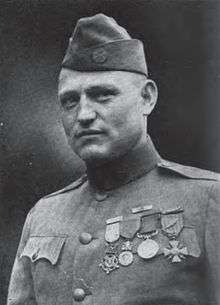
- Miloš Obilić, knight during the invasion of the Ottoman Empire
- Čolak-Anta, military commander and one of the most important figures of the First Serbian Uprising
- Vuk Isaković, military commander in Austrian service during the Austrian-Ottoman Wars
- Vukajlo Božović, Serbian Orthodox priest and revolutionary who participated in the Balkan Wars as a commander of a detachment in Ibarski Kolašin
- Jake Allex, Serbian American soldier who received the Medal of Honor for his service in the U.S. Army during World War I
- Boro Vukmirović, one of the organizers of the anti-fascist uprising in Kosovo
- Živko Gvozdić, commander in the Balkan Wars and World War I
- Kosta Pećanac, Chetnik commander
- Lazar Kujundžić, Chetnik commander
- Sava Petrović-Grmija, Chetnik soldier
- Božidar Delić, general of the Army of Yugoslavia
- Veljko Radenović, Serbian police general
- Zoran Radosavljević, pilot
Writers
- Vladislav the Grammarian, an Orthodox Christian monk, scribe, historian and theologian
- Dimitrije Kantakuzin, writer who lived in the 15th century
- Elder Grigorije, Serbian Orthodox clergyman and writer
- Konstantin Mihailović, author of a memoir of his time as a Jannissary in the army of the Ottoman Empire.
- Lazar Vučković, poet
- David Albahari, Serbian Jewish writer
- Darinka Jevrić, poet
- Dejan Stojanović, poet, writer and essayist
- Novica Petković, writer, professor and member of ANURS
- Mošo Odalović, poet
Education
- Radivoje Papović, Rector of the University of Pristina
- Nebojša Radunović, professor of Obstetrics and Gynecology at University of Belgrade's School of Medicine and a corresponding member of the Serbian Academy of Sciences and Arts
- Marko Savić, pianist and professor at the University of Pristina Faculty of Arts
- Anđelko Karaferić, musician, Professor of Counterpoint and Associate Dean at the University of Pristina Faculty of Arts
- Andrijana Videnović, actress and Associate Professor of Diction at the University of Pristina Faculty of Arts
- Jasmina Novokmet, conductor, professor and former Associate Dean at the University of Pristina
- Aleksandra Trajković, pianist, Assistant Professor of Piano and Chief of the Piano Department at the University of Pristina
- Tomislav Trifić, graphic artist and Dean of the University of Pristina Faculty of Arts
- Gligorije Elezović, historian and member of the Serbian Academy of Science and Arts
- Radoš Ljušić, historian and professor
- Branibor Debeljković, artist, historian and professor
- Slađana Đurić, professor of philosophy and sociology
Performing arts
Cinema and theatre
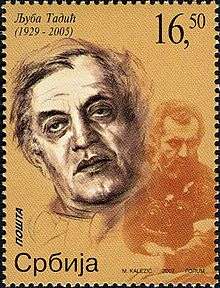
- Ljuba Tadić, Dobričin prsten and four-time Golden Arena for Best Actor winner
- Mira Stupica, Dobričin prsten and Golden Arena for Best Actress winner
- Dragoslav Ilić
- Dragan Maksimović
- Miodrag Krivokapić
- Saša Pantić
- Milan Vasić
- Predrag Vasić
Music

- Jordan Nikolić, folk singer who interpreted traditional songs from Kosovo
- Brankica Vasić Vasilisa, performer of traditional songs from Kosovo & Metohija and Macedonia
- Milica Milisavljević Dugalić, performer of traditional songs from Kosovo & Metohija
- Bora Spužić, folk singer
- Dragica Radosavljević Cakana, folk singer
- Viktorija, rock artist who represented Yugoslavia in the Eurovision Song Contest 1982 as part of Aska
- Sejo Kalač, folk singer
- Đani, folk singer
- Jana, folk singer
- Tina Ivanović, folk singer
- Slađa Delibašić, pop singer and dancer
- Peđa Medenica, pop-folk singer
- Stefan Đurić Rasta, popular musician
- Nevena Božović, pop singer who represented Serbia in the Junior Eurovision Song Contest 2007 and with band Moje 3 in the Eurovision Song Contest 2013
Visual art
- Svetomir Arsić-Basara, sculptor
- Branibor Debeljković, photographer
- Trajko Stojanović Kosovac, graphic artist, painter, scenographer
- Slobodan Trajković, painter
Sport
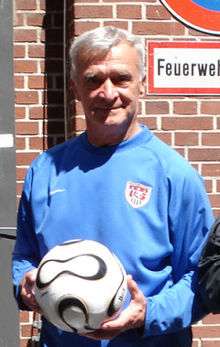
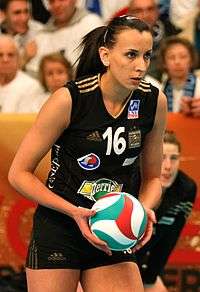

- Milutin Šoškić, football player and Olympic champion
- Vladimir Durković, football player and Olympic champion
- Stevan Stojanović, football goalkeeper and European Cup champion
- Goran Đorović, football player
- Ranko Popović, football player and coach
- Mladen Dodić, football player and coach
- Dragoljub Bekvalac, football player and coach
- Darko Spalević, football player
- Nenad Stojković, football player
- Nikola Lazetić, football player
- Miloš Krasić, football player and 2009 Serbian Footballer of the Year
- Milan Biševac, football player
- Miodrag Anđelković, football player
- Aleksandar Čanović, football player
- Miroslav Vulićević, football player
- Miloš Ostojić, football player
- Milan Milanović, football player
- Aleksandar Paločević, football player
- Đorđe Jovanović, football player
- Sreten Mirković, boxer and European Amateur Championships silver medalist
- Marko Simonović, basketball player, Olympic and World Cup silver medalist
- Luka Dončić, basketball player
- Miljana Bojović, basketball player
- Bojan Krstović, basketball player
- Dejan Musli, basketball player
- Milena Rašić, volleyball player, European champion and Olympic silver medalist
- Milica Simić, badminton player
- Vaso Komnenić, high jumper
- Darko Radomirović, middle distance and long-distance runner
- Sonja Stolić, middle distance and long-distance runner
- Novak Djokovic, tennis player, World No.1 and 12-time Grnad Slam champion[81]
- Danijela Rundqvist, Swedish ice hockey player and two-time Olympic medalist[82]
Other
- Sima Igumanov, merchant who made a fortune through tobacco trade and invested his fortune in building educational facilities
- Bogdan Radenković, an organizer of the Serbian Chetnik Organization and one of the founders of the Black Hand
- Atanasije Urošević, geographer and ethnologist
- Đorđe Martinović, farmer from who was at the centre of a notorious incident in May 1985
- Zvezdan Jovanović, former paramilitary, JSO Commander and convicted criminal
- Anđelka Tomašević, Miss Earth Serbia 2013 and Miss Universe Serbia 2014
- Katarina Šulkić, Miss Serbia 2015
See also
- Community of Serb Municipalities
- Serbian enclaves in Kosovo
- Enclave (2015 drama film)
- Gorani
- Janjevci
Annotations
- ^ Kosovo is the subject of a territorial dispute between the Republic of Kosovo and the Republic of Serbia. The Republic of Kosovo unilaterally declared independence on 17 February 2008, but Serbia continues to claim it as part of its own sovereign territory. The two governments began to normalise relations in 2013, as part of the Brussels Agreement. Kosovo has received formal recognition as an independent state from 113 out of 193 United Nations member states.
- ^ As of 2015, there are at least 6,600 Kosovo Serb refugees in Montenegro.[74] In 2003, the number was c. 12,000.[75] The numbers do not include those that have received Montenegrin citizenship.
References
- 1 2 3 4 5 ECMI Kosovo 2013.
- ↑ International Business Publications, USA (1 August 2013). Kosovo Business Law Handbook: Strategic Information and Laws. Global Investment Centre, United States. p. 9. ISBN 9781438770222.
- 1 2 Robert Elsie (15 November 2015). Historical Dictionary of Kosovo. Scarecrow Press. p. 256. ISBN 9780810874831.
- ↑ Bataković 2007.
- ↑ "The Medieval Monasteries of Kosovo". The New York Times. 13 September 2016. , "Kosovo: The Jerusalem of Serbia". The Washington Post. July 1999.
- ↑ John K. Cox (2002). The History of Serbia. Greenwood Publishing Group. p. 29.
- ↑ Siobhán Wills (26 February 2009). Protecting Civilians: The Obligations of Peacekeepers. Oxford University Press. p. 219. ISBN 978-0-19-953387-9. Retrieved 24 February 2013. , "Abuses against Serbs and Roma in the new Kosovo". Human Rights Watch. August 1999. , "The Violence: Ethnic Albanian Attacks on Serbs and Roma". Human Rights Watch. July 2004.
- ↑ Petar Vlahović (2004). Serbia: the country, people, life, customs. Ethnographic Museum. p. 392. ISBN 978-86-7891-031-9.
- ↑ Pižurica, Mato; Pešikan, Mitar; Jerković, Jovan (2010). Pravopis srpskoga jezika (4th ed.). Novi Sad: Matica Srpska. ISBN 978-86-7946-105-6.
- ↑ Bogdanović 1986, ch. II, para. 2.
- ↑ Bogdanović 1986, ch. II, para. 3.
- ↑ Bogdanović 1986, ch. II, para. 4.
- ↑ Златарски, II: 141-142; Литаврин, 403-404
- ↑ Sima M. Cirkovic (15 April 2008). The Serbs. John Wiley & Sons. pp. 26–. ISBN 978-1-4051-4291-5.
- ↑ Paul Stephenson (29 June 2000). Byzantium's Balkan Frontier: A Political Study of the Northern Balkans, 900-1204. Cambridge University Press. pp. 142–. ISBN 978-0-521-77017-0. ; Scylitzes Continuatus: 163–165
- ↑ Yuri Stoyanov (1994). The hidden tradition in Europe. Arkana1.
- ↑ Stephanos Efthymiadis (1 April 2016). The Ashgate Research Companion to Byzantine Hagiography: Volume II: Genres and Contexts. Routledge. p. 375. ISBN 9781317043966.
- ↑ Zdenko Zlatar (1995). The Slavic Epic: Gundulić's Osman. Peter Lang Pub Incorporated.
- ↑ Laurence Mitchell (2005). Serbia. Bradt Travel Guides. ISBN 9781841624631.
- ↑ Mario Katic; Tomislav Klarin; Mike McDonald (2014). Pilgrimage and Sacred Places in Southeast Europe: History, Religious Tourism and Contemporary Trends. LIT Verlag Münster. p. 204.
- ↑ Plamen Mitev (2010). Empires and Peninsulas: Southeastern Europe Between Karlowitz and the Peace of Adrianople, 1699–1829. LIT Verlag Münster. p. 172.
- ↑ Anderson, Frank Marby; Amos Shartle Hershey (1918). "The Treaty of London, 1913". Handbook for the Diplomatic History of Europe, Asia, and Africa 1870–1914. Washington, DC: National Board for Historical Service, Government Printing Office.
- ↑ Malcolm, Noel. Kosovo. Pan. p. 253. ISBN 0-330-41224-8.
- 1 2 Antonijević 2009, p. 9.
- ↑ Antonijević 2009, p. 10.
- ↑ Antonijević 2009, p. 24.
- ↑ Fischer 1999, p. 238.
- ↑ Antonijević 2003, Božović 1991, p. 85
- ↑ Mojzes 2011, p. 95.
- ↑ Mojzes 2011, pp. 94–95.
- 1 2 Antonijević 2009, p. 27.
- ↑ Antonijević 2009, pp. 26–27.
- ↑ IBP USA (3 March 2012). Kosovo Country Study Guide Strategic Information and Developments9. Lulu.com. p. 28.
- ↑ "State-building in Kosovo. A plural policing perspective". Maklu. 5 February 2015. p. 53. , "Liberating Kosovo: Coercive Diplomacy and U. S. Intervention". Belfer Center for Science and International Affairs. 2012. p. 69. , "Dictionary of Genocide". Greenwood Publishing Group. 2008. p. 249. , "Kosovo Liberation Army (KLA)". Encyclopædia Britannica. 14 September 2014. , "Albanian Insurgents Keep NATO Forces Busy". Time. 6 March 2001.
- ↑ "KLA Ran Torture Camps in Albania". 29 April 2009. Retrieved 14 September 2016.
- ↑ "Cohen Fears 100,000 Kosovo Men Killed by Serbs". Washington Post. 16 May 1999. Retrieved 28 March 2013.
- ↑ "Remains of Kosovo Albanian war victims found in Serbia". 27 May 2014. Retrieved 29 June 2014.
- ↑ Lewis, Paul (14 December 2010). "Kosovo PM is head of human organ and arms ring, Council of Europe reports". the Guardian.
- 1 2 Bugajski, Janusz (2002). Political Parties of Eastern Europe: A Guide to Politics in the Post-Communist Era. New York: The Center for Strategic and International Studies. p. 479. ISBN 1563246767.
- 1 2 "Abuses against Serbs and Roma in the new Kosovo". Human Rights Watch. August 1999.
- ↑ "After Yugoslavia: Identities and Politics Within the Successor States". 2012. p. 30.
- ↑ "Kosovo Crisis Update". UNHCR. August 4, 1999.
- ↑ "Forced Expulsion of Kosovo Roma, Ashkali and Egyptians from OSCE Participated state to Kosovo". OSCE. October 6, 2006.
- ↑ Siobhán Wills (26 February 2009). Protecting Civilians: The Obligations of Peacekeepers. Oxford University Press. p. 219. ISBN 978-0-19-953387-9. Retrieved 24 February 2013.
- ↑ "Serbia home to highest number of refugees and IDPs in Europe". B92. 20 June 2010.
- ↑ "Serbia: Europe's largest proctracted refugee situation". OSCE. 2008.
- ↑ S. Cross, S. Kentera, R. Vukadinovic, R. Nation (7 May 2013). Shaping South East Europe's Security Community for the Twenty-First Century: Trust, Partnership, Integration. Springer. p. 169. Retrieved 31 January 2017.
- ↑ Ted Olsen (1 March 2004). "Dozens of Churches Destroyed in Kosovo". Christianity Today. Retrieved 14 March 2013.
- ↑ "KLA rebels accused of vandalizing Serb monastery". New York: CNN. 17 June 1999.
- ↑ "Kosovo Declares Independence From Serbia". Geography.about.com. Archived from the original on 7 August 2011. Retrieved 18 October 2011.
- ↑ "US 'absolutely' opposed to Kosovo partition". Agence France Presse. 28 February 2008. Archived from the original on 5 October 2012. Retrieved 9 March 2008.
- ↑ "Kosovo PM: End to Parallel Structures". Balkan Insight. 2008-03-07. Archived from the original on 14 April 2009. Retrieved 2008-03-09.
- ↑ "UN: Kosovo Partition 'Not An Option'". Balkan Insight. 2008-03-05. Archived from the original on 2015-09-24. Retrieved 2008-03-09.
- ↑ Eland, Ivan (2008-02-20). "Prevent trouble with partition of Kosovo". The Detroit News. Retrieved 2008-03-09.
- ↑ "K. Serb leader: Partition talk is nonsense". B92. 25 February 2008. Archived from the original on 28 February 2008. Retrieved 9 March 2008.
- ↑ Robinson, Matt (2008-02-29). "Serbs bid for Bosnia-style division in Kosovo". Reuters. Retrieved 2008-03-09.
- ↑ "EU dismisses Serb autonomy in Kosovo". United Press International. 2008-03-03. Retrieved 2008-03-09.
- ↑ "Serbian president says dividing Kosovo an option: report". Agence France-Presse. 30 September 2008. Archived from the original on 3 October 2008. Retrieved 1 October 2008.
- ↑ "Tadić "not suggesting Kosovo partition"". B92. 1 October 2008. Archived from the original on 4 October 2008. Retrieved 1 October 2008.
- ↑ "Kosovo slams Serb leader's partition claim". Sofia Echo. 2008-10-01. Retrieved 2008-10-01.
- ↑ "Goran Rakic Elected North Mitrovica Mayor | InSerbia News". inserbia.info. Retrieved 2016-10-01.
- ↑ In 1972 the Sarajevo Institute of Middle Eastern Studies translated the original Turkish census and published an analysis of it Kovačević Mr. Ešref, Handžić A., Hadžibegović H. Oblast Brankovića - Opširni katastarski popis iz 1455., Orijentalni institut, Sarajevo 1972. Subsequently others have covered the subject as well such as Vukanović Tatomir, Srbi na Kosovu, Vranje, 1986.
- ↑ (PDF) http://www.eparhija-prizren.com/sites/default/files/users/4/brankovici_popis_pregled.pdf. Missing or empty
|title=(help) - ↑ Das Fürstenthum Serbien und Türkisch-Serbien, eine militärisch-geographische Skizze von Peter Kukolj, Major im k.k.Generalstabe, Wien 1871
- ↑ Detailbeschreibung des Sandzaks Plevlje und des Vilajets Kosovo (Mit 8 Beilagen und 10 Taffeln), Als Manuskript gedruckt, Vien 1899, 80–81.
- ↑ "Report on the size and ethnic composition of the population of Kosovo" (PDF). ICTY. 14 August 2002.
- 1 2 Statistics Office of Kosovo, World Bank (2000), OSCE (2007)
- ↑ Bor. M. Karapandžić (1986). Srpsko Kosovo i Metohija: zločini Arnauta nad srpskim narodom. sn.n. p. 18.
... надбискуп Барски Марин Бици 1610, надбискуп албанске народности Петар Масарек 1623. године и надбискуп ...
- ↑ "UN rights chief urges broad cooperation to achieve comprehensive settlement in Kosovo". UN News Center. Retrieved 18 June 2013.
- ↑ "Human Rights Watch: Abuses Against Serbs And Roma In The New Kosovo (August 1999)". Hrw.org. Retrieved 18 October 2011.
- ↑ "Srpska zajednica na Kosovu" (PDF). helsinki.org.rs (in Serbian). Helsinki Committee for Human Rights in Serbia. 2012. Retrieved 11 June 2015.
Prema ocenama...broj Srba na Kosovu je između 90.000 i 120.000. [According to the estimates, the number of Serbs in Kosovo is between 90.000 to 120.000]
- ↑ "ECMI: Minority figures in Kosovo census to be used with reservations". ECMI.
- ↑ "UNHCR: Returns to Kosovo halted". B92. 2010-04-05. Archived from the original on 31 December 2014.
1 August 2009 UNHCR
- 1 2 "Izbeglice sa Kosova protiv Tačijeve posete". 2015-01-12.
Procene pokazuju da, 15 godina nakon završetka sukoba, u Crnoj Gori živi više od 6,600 kosovskih Srba. Većina njih još živi u privremenim izbegličkim naseljima i nemaju lična dokumenta.
- 1 2 Radević, Dragana (2005). "Izbjeglice i interno raseljene osobe u Crnoj Gori–trajna rješenja".
Crna Gora je pružila (ili pruža) utočište za 18.047 interno raseljenih osoba s Kosova od kojih je većina izbjegla 1999., a manji broj njih 2000. (Izvještaj o registracijiraseljenih lica..., 2003). Među interno raseljenima trećina su Romi, a najviše ih je smješteno u romskim naseljima, gdje su izmiješani s lokalnim sunarodnjacima ... Ukupan broj raseljenih u Crnoj Gori je približno 26.500
- ↑ Dietmar Müller, Staatsbürger aus Widerruf: Juden und Muslime als Alteritätspartner im rumänischen und serbischen Nationscode: ethnonationale Staatsbürgerschaftskonzepte 1878–1941, p. 183-208. ISBN 3-447-05248-1, ISBN 978-3-447-05248-1
- ↑ Religion and the politics of identity in Kosovo, p. 73: see footnotes
- ↑ Novosti Online, 7 July 2011, Upisuju Srbe kao Albance
- ↑ Isabelle Dierauer (16 May 2013). Disequilibrium, Polarization, and Crisis Model: An International Relations Theory Explaining Conflict. University Press of America. p. 88. ISBN 978-0-7618-6106-5.
- ↑ Serbian Folk Dance Tradition in Prizren Ethnomusicology, Vol. 6, No. 2 (May, 1962)
- ↑ Đoković to visit northern Kosovo Thursday Accessed 10 April 2015. "Đoković, whose family is originally from Kosovo, will be in the province to support the Serbs there..."
- ↑ "Danijela Rundqvist blog". Retrieved 14 February 2010.
Sources
- Le Kosovo-Metohija dans l'histoire serbe. L'AGE D'HOMME. 1990. ISBN 978-2-8251-0139-1. (in French)
- Avramović, Zoran (2007). Istorija i književnost Srba Kosova i Metohije. ISBN 978-86-85047-11-4. (in Serbian)
- Bataković, Dušan T. (2007). Kosovo and Metohija: living in the enclave. SANU.
- Branislav Đ. Nušić. "Kosovo: opis zemlje i naroda". (in Serbian) (Public Domain)
Further reading
- Books
- Antonijević, Nenad (2009). Mirković, Jovan, ed. Албански злочини над Србима на Косову и Метохији у Другом светском рату, документа (PDF) (2nd ed.). Belgrade: Музеј жртава геноцида.
- Bogdanović, Dimitrije (1985). Књига о Косову [The Book on Kosovo]. Beograd: SANU.
- Bogdanović, Dimitrije (1986) [1984]. "KNJIGA O KOSOVU". SANU; Rastko.
- Božović, Branislav (1991). Surova vremena na Kosovu i Metohiji: kvislinzi i kolaboracija u drugom svetskom ratu. Institut za savremenu istoriju.
- Ćurčić, Slobodan (1979). Gračanica: King Milutin's Church and Its Place in Late Byzantine Architecture. Pennsylvania State University Press.
- Dželetović, Pavle Ivanov (2004). Злочини Арбанаса над Србима. Belgrade: Геополитика.
- Fischer, Bernd J. (1999). Albania at War, 1939-1945. C. Hurst & Co. Publishers. ISBN 978-1-85065-531-2.
- Jovanović, J. (1941). Južna Srbija od kraja XVIII veka do oslobođenja. Beograd: Geca Kon.
- Karapandžić, Bor. M. (1986). Srpsko Kosovo i Metohija: zločini Arnauta nad srpskim narodom. sn.n.
- Mikić, Đorđe (1988). Društvene i ekonomske prilike kosovskih srba u XIX i početkom XX veka. SANU.
- Mojzes, Paul (2011). Balkan Genocides: Holocaust and Ethnic Cleansing in the 20th Century. Lanham: Rowman & Littlefield.
- Perunović, Branko (1989). Зулуми ага и бегова у Косовском вилајету. Belgrade.
- Popović, Zarija R. (1900). Pred Kosovom: beleške iz doba 1874-1878 godine. Drž. štamp. Kralj. Srbije.
- Stojančević, Vladimir (1998). Srpski narod u Staroj Srbiji u Velikoj istočnoj krizi 1876-1878. Službeni list SRJ.
- Journals
- Antonijević, Nenad (2003). Stradanje srpskog i crnogorskog civilnog stanovništva na Kosovu i Metohiji 1941. godine. Dijalog povjesničara-istoričara. 8. Zadar: Friedrich Nauman Stiftung. pp. 355–369.
- Zdravković-Zonta, Helena (2011). "Serbs as threat the extreme negative portrayal of the Serb "minority" in Albanian-language newspapers in Kosovo". Balcanica (42): 165–215. doi:10.2298/BALC1142165Z.
- Conference papers
- Pejin, Jovan (2006). "The Extermination of the Serbs in Metohia, 1941-1944" (PDF). Срби на Косову и у Метохији: Зборник радова са научног скупа. Београд: Српска академија наука и уметности. pp. 189–207.
External links
- "Community Profile: Serb Community" (PDF). ECMI Kosovo. 2013.
- Filling the Vacuum: Ensuring Protection and Legal Remedies for Minorities in Kosovo by Minority Rights Group International (May 2009)
- Groups working with all demographics in Kosovo

